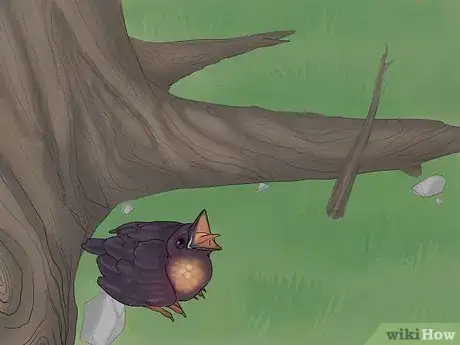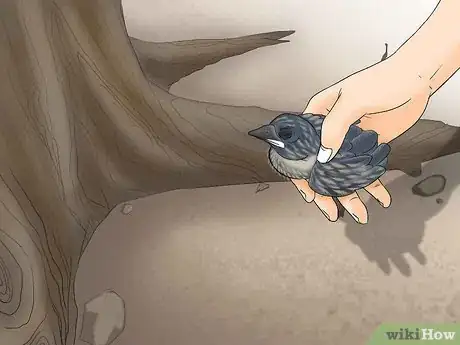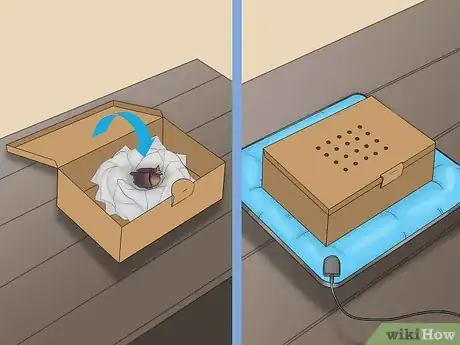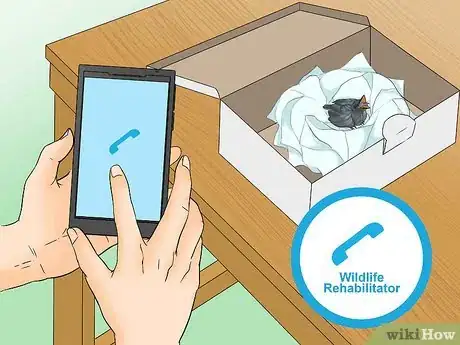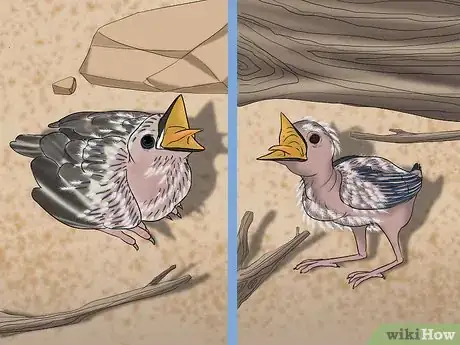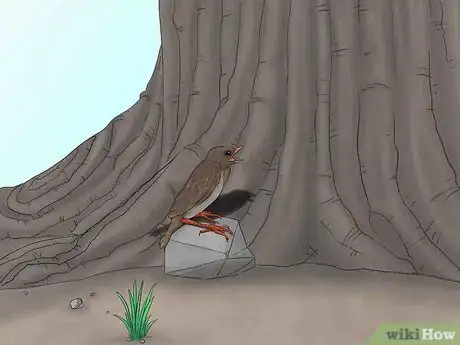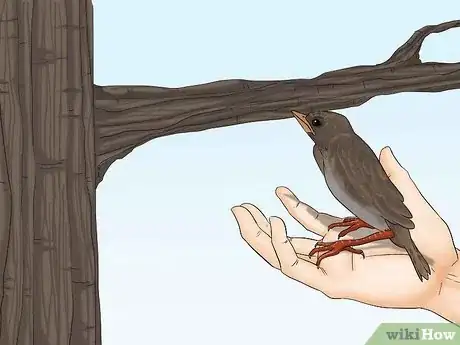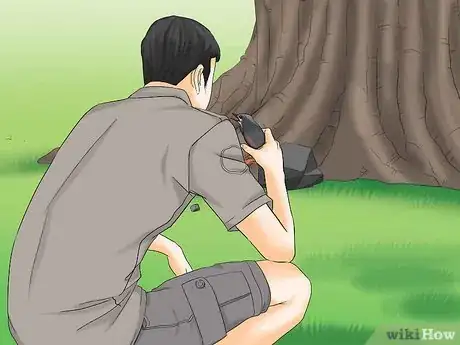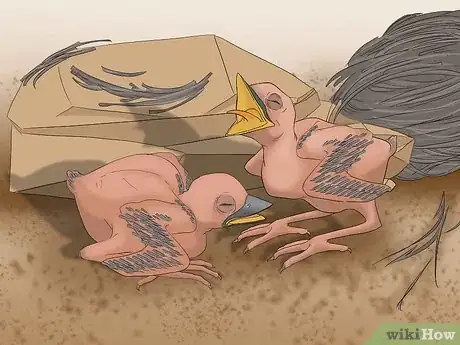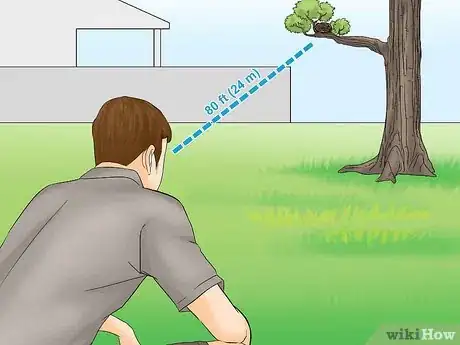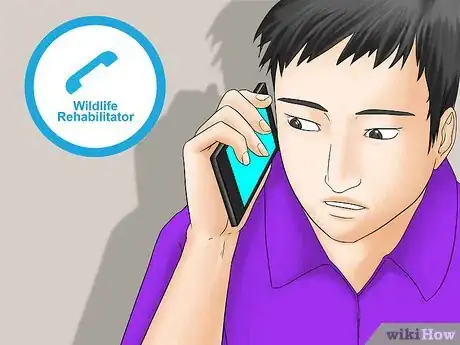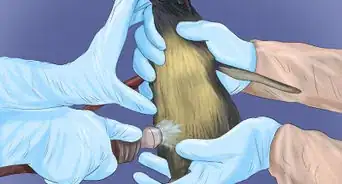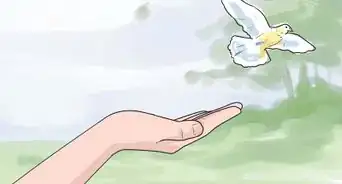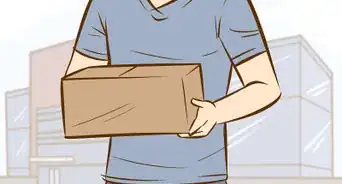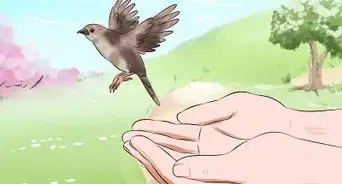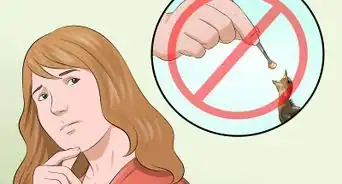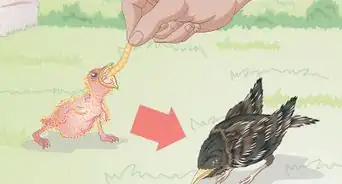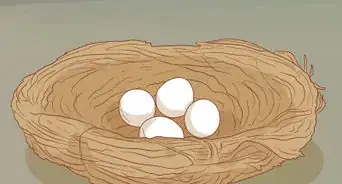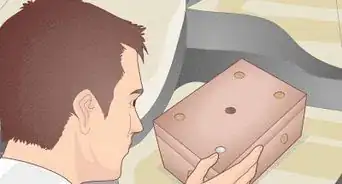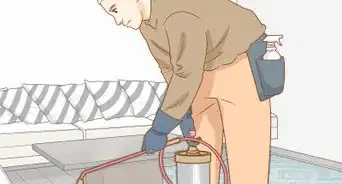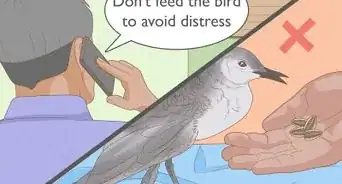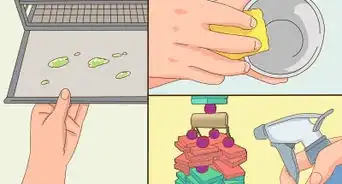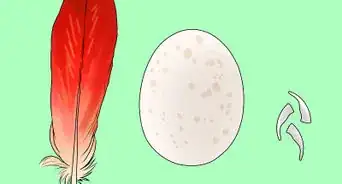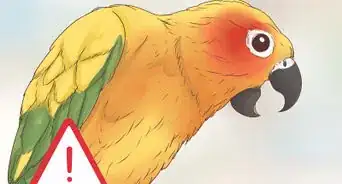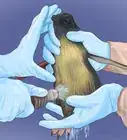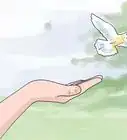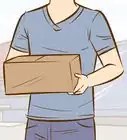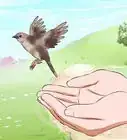This article was co-authored by Jeff Jones and by wikiHow staff writer, Christopher M. Osborne, PhD. Jeff Jones is a Bird Specialist based in Nashville, Tennessee. He is the writer of BirdOculars, a website dedicated to helping people become better birders. He has over 18 years of experience and specializes in feeding birds and wildlife. Jeff experiments to find ways to encourage birds he wants to study and his website help others to do the same.
wikiHow marks an article as reader-approved once it receives enough positive feedback. In this case, several readers have written to tell us that this article was helpful to them, earning it our reader-approved status.
This article has been viewed 84,854 times.
Even though you mean well, temporarily caring for a baby bird may make it unable to adjust properly when you release it back into the wild. Instead, if you determine that a nestling (a mostly featherless newborn) or fledgling (a feathered baby that's nearly ready to fly) is truly in need of help, you should build it a temporary shoebox nest and get it to a trained wildlife rehabilitator as soon as possible. If the baby bird isn’t injured but has fallen from its nest, you should do the minimum required to return it to safety and let its parents take over.
Steps
Nesting an Injured Bird until You Can Get Help
-
1Confirm the bird is injured before you try to help it. When you see a baby bird on the ground, your instinct may be to bring it inside and nurse it back to health. However, unless the bird has an actual injury, you’ll probably do more harm than good this way.[1]
- Look for the following signs of injury or illness in both nestling and fledgling baby birds: bleeding or open wounds; lifelessness, with very little movement; appearing exhausted or dehydrated.
- If the bird is sitting calmly or is moving around, it probably isn’t injured.
- If you’re not sure, call a wildlife rehabilitator for guidance (see the step later in this section).
-
2Scoop up the bird gently with clean or gloved hands. Whenever possible, wash your hands and/or put on gloves to limit the transfer of bacteria or viruses. Then, place one thumb against the back of the bird’s neck and scoop your other fingers beneath and around the bird. If the baby bird is too big for one hand, use both thumbs and scoop with both sets of fingers on opposite sides.[2]
- Grip the bird only tightly enough to prevent it from falling or escaping. Don’t squeeze it.
- Also wash your hands thoroughly after you’re done handling the bird.
Advertisement -
3Line a shoebox with a T-shirt or paper towels, and poke holes in the lid. Any standard cardboard shoebox will do. Stick a folded-up T-shirt or several paper towels in the bottom to create a soft base. Use a pen or screwdriver to poke at least 12 holes in the lid.[3]
- Ideally, you’ll either have someone else prepare the box while you keep holding the bird, or create an emergency nest box ahead of time for just such an occasion.
- Otherwise, you’ll have to work on the box with one hand while you hold the bird with the other, or find a soft, secure temporary spot (e.g., a deep bowl lined with paper towels) while you work.
-
4Create a facial tissue nest in the box, and nestle the bird in the middle. Fashion about 12 tissues into a donut shape in the center of the shoebox. Make the hole in the middle just large enough for the bird to fit. Then, gently lower the bird into the center of the tissue nest and release your hold.[4]
- The sides of the tissue nest should not be higher than the bird’s head—press them down some or remove a few tissues if necessary.
- A fledgling bird might move out of this spot and around the box—that’s OK.
- If the bird is unable to sit squarely over its legs with its head upright, try to position the tissues around it to prop it up.
-
5Tape the lid onto the box and lay it on a warm heating pad. Especially if you’re dealing with a feathered fledgling bird that could potentially escape, put the lid on right away and secure it with tape. But, in any case, put a lid on to keep the temporary nest dark, quiet, and cozy.[5]
- If you have a heating pad, place it on its lowest setting and set the shoebox on top of it. If you don’t have one, place the box in a warm, quiet spot in your house.
-
6Contact a wildlife rehabilitator and take the bird to them. Time is of the essence here—if you can get the bird to a wildlife rehabilitator within 1-2 hours, its chances of survival will be much greater. Once you make contact with a rehabilitator, put the shoebox in your car and drive to their location as soon as you can.[6]
- Call your government’s environmental, natural resources, wildlife, or similar department to find local wildlife rehabilitators. Or, try websites such as https://ahnow.org/#/.
- Do not try to give the bird food or water unless specifically directed to do so by the wildlife rehabilitator. It’s very easy to unintentionally drown, choke, or poison a baby bird.
Helping a Healthy Fledgling
-
1Identify a fledgling by its feathers and adult-like features. Unlike nestlings, which are either bare-skinned or have a downy coating, fledglings have typical bird feathers—although perhaps with a bit of residual “fluff.” They essentially look like slightly-awkward adult birds, as they are in the early stages of learning to fly and will soon leave their parents’ nest for good.[7]
- So, if it looks like an adult bird but can’t quite yet fly, it’s almost certainly a fledgling and can be left alone unless it’s clearly injured or in imminent danger.
-
2Leave the bird alone if it appears healthy and safe. Fledglings are commonly found on the ground beneath their nests, and this is completely normal. Hopping and/or fluttering down from the nest is part of their transition to independence. The bird’s parents will continue to care for it until it is ready to care for itself.[8] In between feeding the fledgling, they may leave it alone to attract less attention to it.
- If the fledgling is uninjured and in the vicinity of its nest, it has a fair chance of avoiding predators (by running, hopping, or flying short distances) and reaching adulthood.
- The bird is actually less likely to reach a healthy adulthood if you take it into your home, try to care for it, and then attempt to release it back into the wild.
-
3Place it on a low branch to protect it from a predator. There’s really only one time you should consider picking up an uninjured fledgling that’s near its nest—that is, if it is in obvious danger. For example, if you know there’s a cat lurking around, you may want to pick up the bird and quickly deposit it on a low branch—higher than the cat is likely to reach, but not all the way up to the nest.[9]
- Using one or both hands (which should be washed, gloved, or both), place your thumbs on the back of the bird’s neck and use your fingers to scoop under and around the bird. Deposit the bird on the low branch, then wash your hands and leave the immediate area so the parents can continue their care.
-
4Call a wildlife rehabilitator only if no nest is in sight. If you see scattered nest debris or have other reasons to believe the nest has been destroyed, then it is appropriate to contact a wildlife rehabilitator for assistance. Based on your description of the bird and its situation, they may advise you to bring the bird to them, or may tell you that the bird is likely ready to make it on their own.[10]
- To find wildlife rehabilitators, contact your local government authority that deals with wildlife or natural resources, or search online.[11]
Returning a Healthy Nestling to Its Nest
-
1Identify a nestling by its fluffy coating or bare skin. Nestling birds either have bare skin, a fluffy down-like coating, or a mix of down and some very thin pin-feathers. They usually look pear-shaped with undersized wings, they can’t fly, and they are helpless outside of the nest and their parents’ care.[12]
- If you find a nestling on the ground, look straight up—the nest will almost always be somewhere directly above. If possible, take a quick peek into the nest to confirm that the nestling on the ground looks like the ones still in the nest.
- If you cannot find a nest in the immediate area, treat the nestling as injured and get in touch with a wildlife rehabilitator.
-
2Scoop up the nestling carefully, and place it gently into the nest. Wash your hands and/or put gloves on, then pick up the bird by putting your thumb on the back of its neck and scooping your fingers under and around its body. Deposit it into the nest as quickly and calmly as possible.[13]
- Don’t risk you own safety trying to reach a nest that is too high or is otherwise inaccessible, though. Contact a wildlife rehabilitator in this case.
- Wash your hands thoroughly after handling the nestling.
-
3Watch quietly from at least 80 ft (24 m) away until the parents arrive. The nestling's parents won’t return if you—a large predator—are still in the area. Relocate to a spot where you can still see the nest but are well out of the way—80 ft (24 m) is a good minimum distance.[14]
- Birds rarely leave their nestlings alone for more than a few minutes, unless there are potential predators (like you) in the area. So, you probably won’t have to keep an eye on the nest for long.
- Once you spot an adult bird returning to the nest, you can rest assured that the nestling will be cared for. It is a myth that birds will reject a nestling that has a human scent on it.
-
4Call a wildlife rehabilitator if the parents don’t return or the bird falls again. Give the parents at least 30 minutes, and ideally 1 hour, to return to the nest. If you don’t see them return during this time period, you can assume they aren’t coming back at all. In this case, contact a wildlife rehabilitator in your area and follow their guidance.[15]
- Use a web search to find wildlife rehabilitators, or call your government agencies charged with overseeing the environment and/or wildlife.[16]
Community Q&A
-
QuestionHow much do I feed my baby robin?
 Community AnswerA baby robin should be fed as much as it can eat at least every half hour from sunrise to sunset. You can take a 2-3 hour break maybe once a day.
Community AnswerA baby robin should be fed as much as it can eat at least every half hour from sunrise to sunset. You can take a 2-3 hour break maybe once a day. -
QuestionI'm afraid my sparrow has imprinted, how can I tell if this is the case, and can I reverse this if I wanted to release him into the wild?
 Community AnswerIf he is imprinted, he will not survive in the wild. I don't think you could reverse this, so you may have to continue to care for him. If you don't have time, take him to an animal/bird sanctuary.
Community AnswerIf he is imprinted, he will not survive in the wild. I don't think you could reverse this, so you may have to continue to care for him. If you don't have time, take him to an animal/bird sanctuary. -
QuestionWhat do sparrows eat?
 Community AnswerMainly insects, worms, woodlouse, ants, crickets etc. I also fed my babies wet cat food in pouches and chick feed mix.
Community AnswerMainly insects, worms, woodlouse, ants, crickets etc. I also fed my babies wet cat food in pouches and chick feed mix.
Warnings
- All native songbirds are protected by the Migratory Bird Treaty Act. It is illegal to keep any wild birds as pets, except for house sparrows, starlings, and pigeons.⧼thumbs_response⧽
- A bird that has imprinted on you after you’ve given it care, or thinks that you are its species, will not survive in the wild.⧼thumbs_response⧽
References
- ↑ https://www.audubon.org/news/when-you-should-and-should-not-rescue-baby-birds
- ↑ https://www.audubon.org/news/when-you-should-and-should-not-rescue-baby-birds
- ↑ https://bestfriends.org/resources/baby-bird-rescue
- ↑ https://bestfriends.org/resources/baby-bird-rescue
- ↑ https://bestfriends.org/resources/baby-bird-rescue
- ↑ https://www.audubon.org/news/when-you-should-and-should-not-rescue-baby-birds
- ↑ https://bestfriends.org/resources/baby-bird-rescue
- ↑ https://www.audubon.org/news/when-you-should-and-should-not-rescue-baby-birds
- ↑ https://bestfriends.org/resources/baby-bird-rescue
- ↑ https://bestfriends.org/resources/baby-bird-rescue
- ↑ https://bestfriends.org/resources/other-animals/wildlife-rehabilitator-how-find-one
- ↑ https://bestfriends.org/resources/baby-bird-rescue
- ↑ https://www.audubon.org/news/when-you-should-and-should-not-rescue-baby-birds
- ↑ https://bestfriends.org/resources/baby-bird-rescue
- ↑ https://bestfriends.org/resources/baby-bird-rescue
- ↑ https://bestfriends.org/resources/other-animals/wildlife-rehabilitator-how-find-one
About This Article
To release wild baby birds, you can place uninjured fledglings on limbs that are out of reach of predators and let the fledglings take it from there. If you discover an injured baby bird that's fallen from its nest, you can scoop it up gently and place it back into the nest. If you can't find the nest or if you don't know what to do, the best course of action for you and the bird is to contact a local wildlife rehabilitator. For tips on creating a temporary nest for an injured bird, read on!
